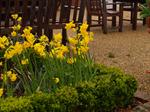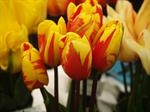Growing Bulbs
Bulbs For Cut Flowers or Seasonal Colour in the Garden
A true bulb consists of swollen fleshy or scale like leaves or leaf bases arising from a basal plate. Most home gardeners however, generally refer to bulbs as those plants which store food in a part of the plant below the ground. This includes the true bulbs, corms, tubers and some swollen rhizomes. These types of plants provide some of our most spectacular flowering displays. Some are also very fragrant.
A swollen root or bulb does not need heavy feeding when first planted as it will initially utilise its stored food supply. Because they are all grown for flowers, they generally need larger amounts of potash than other nutrients. They usually also have a dormant period and can be susceptible to rotting if left in a moist situation during dormancy (i.e. their metabolism is slow in dormancy; this means their defence mechanisms are lower).
- Most bulbs prefer a rich, organic, well drained loam. They thrive on soil which has been prepared with rotted manure or compost prior to planting.
- Sunny but cool positions are excellent. They can often burn if there is too much heat or wind.
- You can grow bulbs anywhere, anytime, but you need the appropriate type for your locality.
- Though most common bulbs are grown in temperate climates, some only do their best in a tropical climate.
- If you want your display of single flowering bulbs to last a little longer – plant half the bulbs upside down. That way it takes longer for the shoots to break the surface and consequently for the bulbs to flower.
 For many bulbs, the foliage dies down after flowering, leaving only the dormant bulb in the soil. While in this dormant state, some bulbs are susceptible to rotting, attack by pests, etc. This can occur if the bulb is not particularly hardy in your climate, or if you apply irrigation water at times of the year when the bulb is used to experiencing dry conditions. For this reason many bulbs are lifted and stored in a clean, dry and dark place to protect them from deteriorating. Some bulbs however, do not benefit at all from lifting. It disturbs their root system and can even result in the death of the plant.
For many bulbs, the foliage dies down after flowering, leaving only the dormant bulb in the soil. While in this dormant state, some bulbs are susceptible to rotting, attack by pests, etc. This can occur if the bulb is not particularly hardy in your climate, or if you apply irrigation water at times of the year when the bulb is used to experiencing dry conditions. For this reason many bulbs are lifted and stored in a clean, dry and dark place to protect them from deteriorating. Some bulbs however, do not benefit at all from lifting. It disturbs their root system and can even result in the death of the plant.
Planting
Always make sure that you plant bulbs to the recommended depth.
- If you plant them too deep their shoots may not reach the surface.
- If you plant them too high they will topple over once they begin to grow.
- Ensure that the soil is both friable (crumbly) and firm to allow root penetration and stability of the emerging plant.
When you first plant out bulbs, you should provide them with a friable soil that has been fertilised with compost and/or an organic fertiliser. Bulbs will not grow well in heavy soils with low nutrients.
 The best time to fertilise bulbs that become dormant is after they have flowered. It is during this time that they store the energy that they will use to produce flowers in the following year. It is for this reason that you should only remove the old leaves from bulbs when they are no longer green. If you have not removed the flowers to use in flower arrangements, it can also be beneficial to remove the spent flower heads, as this will prevent the plant from putting its energy into seed creation.
The best time to fertilise bulbs that become dormant is after they have flowered. It is during this time that they store the energy that they will use to produce flowers in the following year. It is for this reason that you should only remove the old leaves from bulbs when they are no longer green. If you have not removed the flowers to use in flower arrangements, it can also be beneficial to remove the spent flower heads, as this will prevent the plant from putting its energy into seed creation.
Learn about Cut Flower Bulbs and much more ...
ACS offer an extensive selection of gardening and horticulture courses. Whether you are looking to learn more about cut flower bulbs, growing different plant varieties, plant propagation and more, take a look at our selection of Horticulture courses.
We offer courses suitable for home gardeners and professionals - for the development of knowledge for your hobby, or professional training for your career or business. All of our courses have been developed and are tutored by expert horticulturists. Although our courses are studied by distance learning, they include practical exercises and tasks. If you would like to find out more about studying with ACS, get in touch with our specialist Horticulture tutors today.
[14/03/2025 22:53:27]
More from ACS
Over 150 short courses, certificates and diplomas covering landscaping, crops, plants of all types and general gardening.